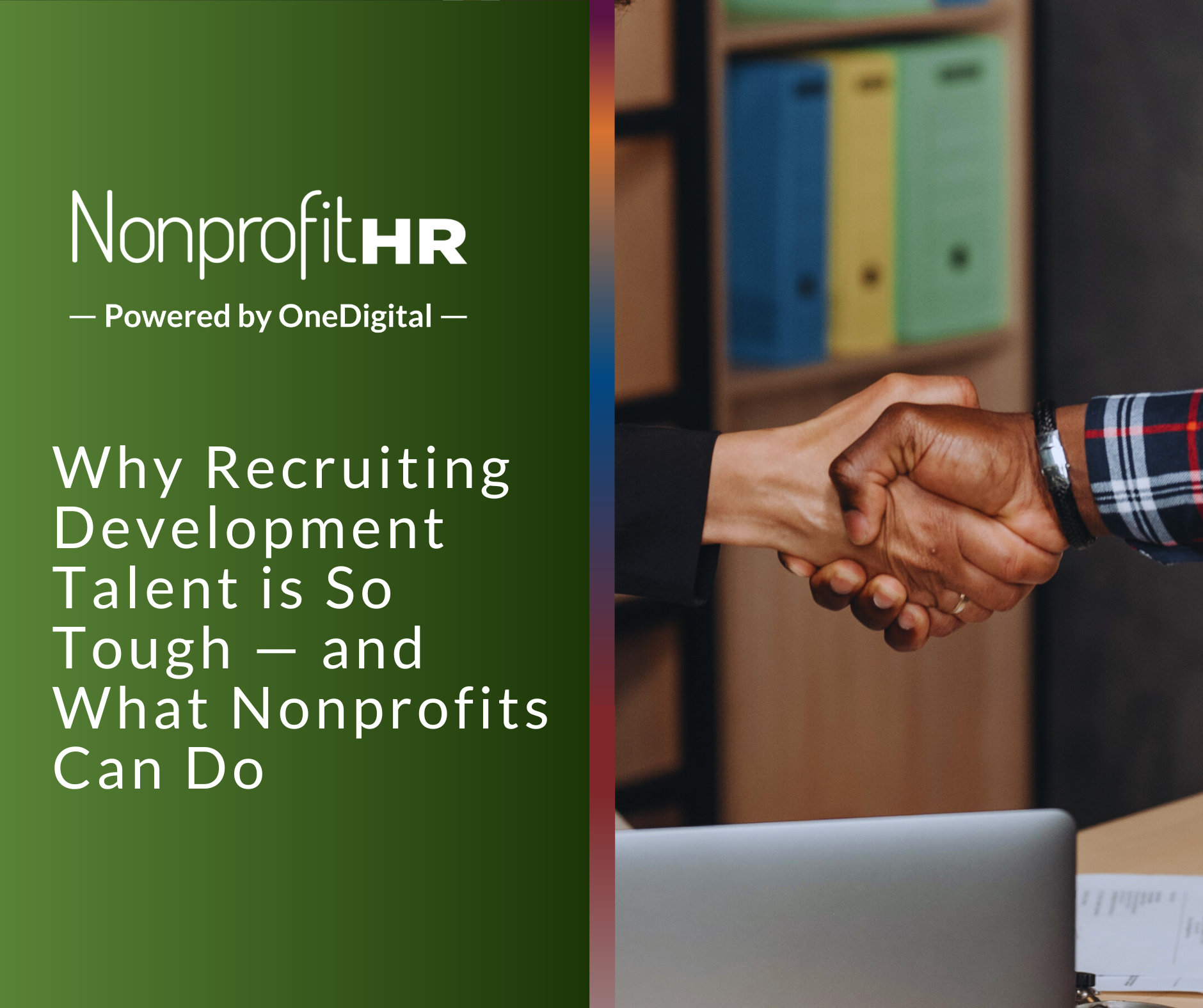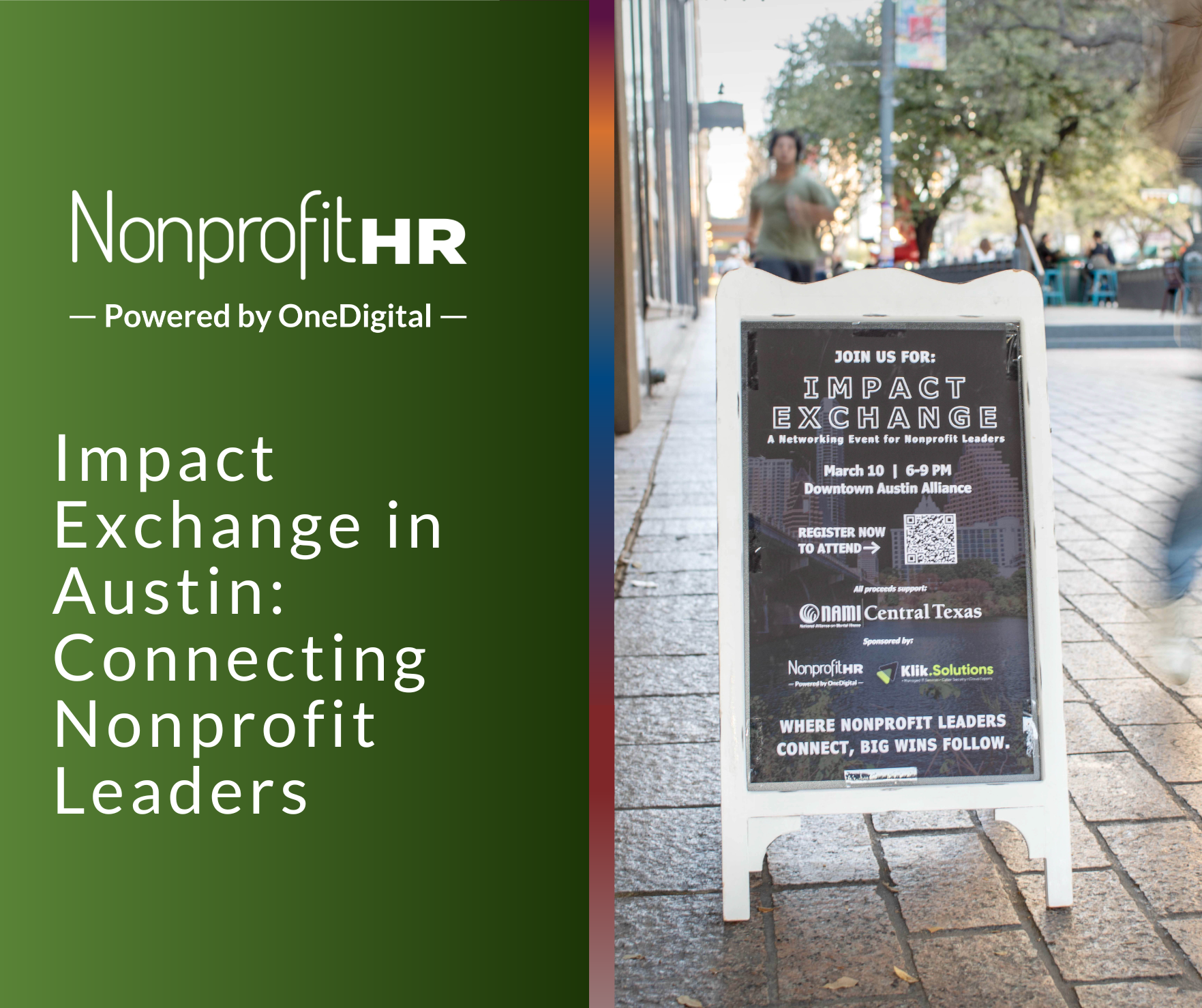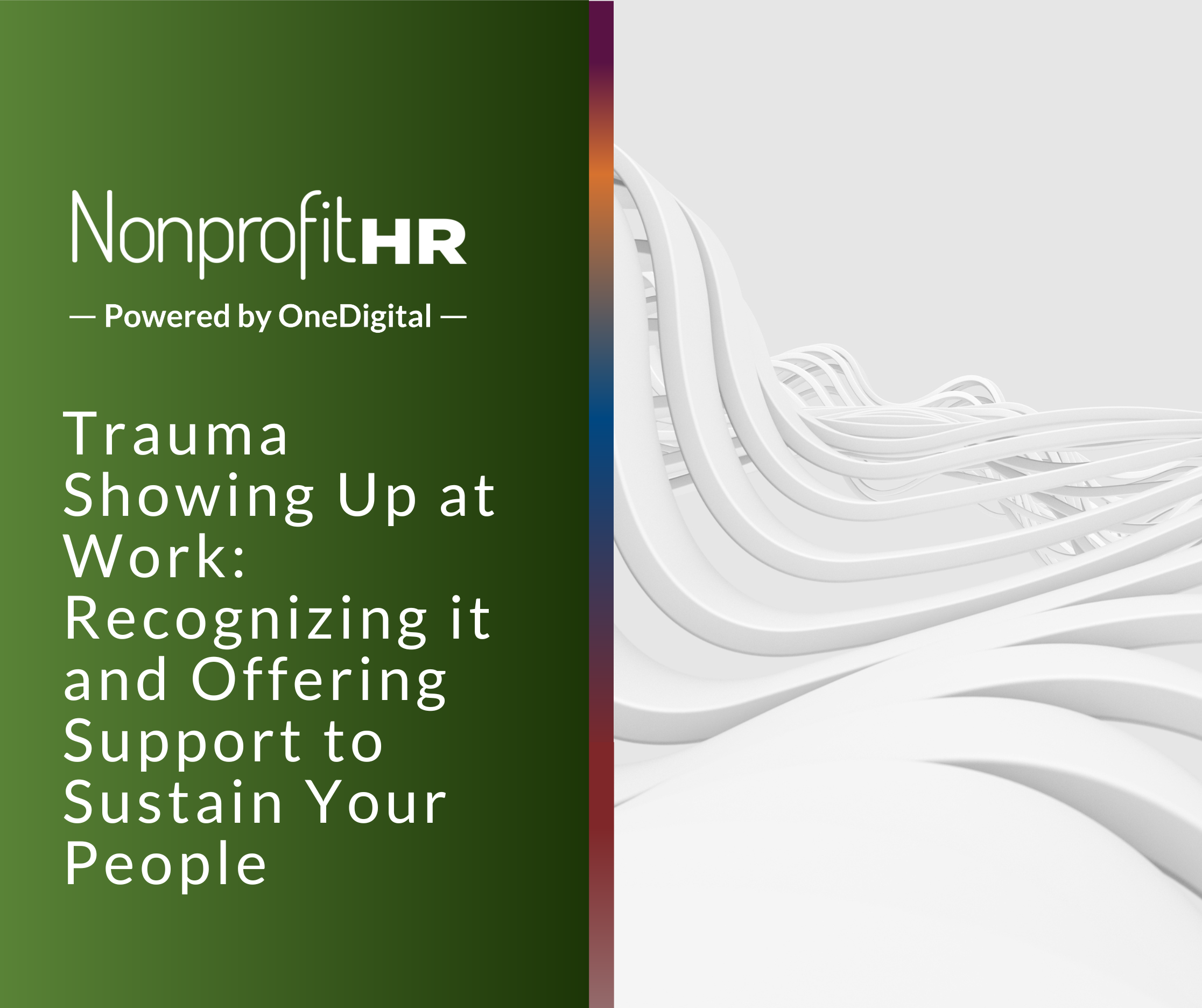WTOP: 5 ways nonprofits can…
Guest blog: written by Michael Watson
National Breast Cancer Foundation was founded in 1991 by breast cancer survivor, Janelle Hail. She was diagnosed with breast cancer in 1980 at the age of 34. At the time of her diagnosis, there was little information about the disease, and she was forced to make a decision about her health with few options. After her treatment, Janelle made a commitment to help women around the world by educating them about breast cancer and the importance of early detection.
Today, NBCF’s mission is to provide help and inspire hope in women affected by breast cancer through early detection, education and support services.
Nonprofit HR discussed the importance of maintaining a healthy workforce with Douglas Feil, VP of Programs and Kelly Simants, VP of Human Resources and gathered insights on how nonprofit leaders can invest in their teams’ wellness.
Tell us about your roles in the National Breast Cancer Foundation.
Douglas Feil: As VP of Programs, my role is to serve and help people facing breast cancer. With each daily task, I ask myself these questions:
- Will this fulfill the NBCF mission of helping women now?
- Does my work inspire others to join me?
I want my role and my work to always help ease the pain and burden of a breast cancer diagnosis.
Kelly Simants: As VP of Human Resources, my role is to provide best-in-class HR services to our staff so that they can thrive in the workplace. We also recently launched an initiative called “Navigating Breast Cancer in the Workplace” where we help employers understand how to better support women dealing with breast cancer in the workplace. I’m passionate about this initiative because there are so many creative ways employers can help a woman who is diagnosed with breast cancer.
What are some things nonprofit leaders might not yet be considering regarding their team’s health and wellness?
We believe that most leaders understand that health is important, but they may not understand that it takes investment. We would compare investing in health and wellness to a retirement account. You must put money into the account in order to see growth over the long term.
That means companies and nonprofits need to invest money into screening and prevention of disease. We know that detecting cancers in the earliest stage is the best way to survive, and the best way to detect cancers early is to screen.
Early detection not only saves lives, but it can reduce cost. The total cost of cancer through healthcare expenditure and loss of productivity exceeds $1 trillion.
According to the World Health Organization, “studies in high-income countries have shown that treatment for cancer patients who have been diagnosed early are two to four times less expensive compared to treating people diagnosed with cancer at more advanced stages.”
Nonprofit leaders must consider the investment in the prevention and early detection of disease in order to improve the health and wellness of their workforce.
How can nonprofit leaders make their workplaces a welcoming environment for team members undergoing medical treatments or adapting to life as a survivor?
If someone on your team is diagnosed with cancer or is undergoing treatment, begin with simply trying to understand and empathize. How would you feel in their situation? Perhaps you or a loved one has been in this situation before – how did you feel? Take these thoughts and feelings and let them be the launch pad of action. Start there.
Next, ask your team member how you can help. It sounds simple, but you might be surprised by the range of responses. Everyone is different, so a one-size-fits-all approach will not work for everyone. As leaders, we often want to work within the confines of a system or plan, but diseases like cancer rarely follow protocols and plans.
If you absolutely must have a plan of action, here’s a good place to start:
Step 1: Try to empathize with the team member.
Step 2: Ask the team member what would be most helpful to them during this time.
Step 3: Create a plan of action to accommodate the team member based on these responses.
Of course, as a leader, you still have business objectives and work needs to get done, but if you truly want to create a welcoming environment for team members facing disease, you have to start with understanding their needs. Organizational objectives will benefit from this level of understanding because the team member will feel empowered, grateful and motivated to succeed.
Ask them what would help them during the time they’re going through treatment as well as when they return to work post-treatment/surgery. Some ideas:
- Their office temperature may need to be adjusted as their body temperature may be different than it was prior to treatment or surgery.
- Consider a part-time schedule, remote options, job share opportunities with another employee, etc.
- Consider the office equipment they use. Their vision may have changed, so perhaps they need a special monitor. You can also conduct an ergonomic assessment of their desk/chair to ensure they have what they need to be comfortable.
What unique challenges do survivors face that nonprofit leaders should be more aware of?
The greatest hope of a person facing cancer is to survive, but it’s hard to imagine the reality of survival in the midst of fighting disease. We’ve talked to many people diagnosed with cancer, and we’re often surprised to find that many survivors don’t feel that sense of triumph after successful treatment. They may feel lucky to be alive, but these emotions are often clouded with resolute feelings of fear, confusion and the lingering question: what’s next?
Younger patients are very fearful because they often know the statistics of recurrence and that next time could be worse. Also, their friends and loved ones who had been very supportive during treatment may be less available once it’s over. Survivors often feel alone after the calls, letters and meal trains end.
Many survivors have said that the challenges are greater on the other side of treatment. Because of this, it’s important for nonprofit leaders to be aware that survivors need continued care – emotional, physical and spiritual. They still need understanding.
The potential physical challenges a survivor can face are endless. If a survivor has been treated with chemotherapy or radiation, these therapies can have lasting physical side effects. Many breast cancer survivors take adjuvant hormonal therapies for 10 years post-diagnosis. These drugs have significant side effects and can alter a breast cancer survivor’s quality of life.
How can nonprofit leaders better support and accommodate team members who are undergoing medical treatments?
Again, it’s important to understand each person’s unique needs. Medical treatments can vary widely. The best place to start is to ask the employee what accommodations they may need.
For example, many breast cancer patients suffer from lymphedema, which is caused by the removal of lymph nodes during treatment. This condition causes swelling and fluid build-up in the arms and legs. If a team member has a job that requires physical labor or movement, they may find this difficult with increased swelling. Their job and role may need to be adjusted as a result.
The Department of Labor provides a free resource that is available to employees and employers with ideas on how to accommodate breast cancer patients, or anyone with a disability for that matter. This resource is available at www.askjan.org.
How can nonprofit leaders better encourage their teams to pursue healthier lifestyles?
We are seeing great success with the implementation of patient navigation in hospitals across the United States. Patient Navigators help guide patients with a suspicious finding through and around the barriers in the complex cancer system to help ensure timely diagnosis and treatment.
We believe that nonprofits and companies alike should consider this same model to help their employees pursue healthier lifestyles. Many large organizations employ Health & Wellness Directors to help create structure and oversight for wellness programs. If the organization is smaller, there may not be a budget for this, but assigning a person or a team to manage the program could be a great place to start.
The program should consist of ways to increase screenings, exercise and healthy eating. It should also encourage ways to decrease unhealthy habits like smoking. Similar to Patient Navigation, it’s also important to eliminate barriers that prevent these lifestyle choices. What is preventing your employees from exercising, eating right and accessing screening? Once those barriers are identified, work to eliminate them.
How can nonprofit leaders navigate budget issues with implementing wellness programs for their team?
As discussed before, it’s been proven that investing in the health of employees actually lowers budget costs in the long-term. It really is a decision of investing now or later. Statistically, 1 in 3 people will get some form of cancer in their lifetime, but finding cancers early prevents expensive treatments and loss of productivity. The best way to find cancers early is to adopt screening programs for all cancer types and encourage your employees to follow these guidelines. It will actually benefit the budget.
Nonprofit HR’s Benefits practice helps organizations think through wellness strategies that ensure better overall health for their teams, even within a tight budget.
How can nonprofit leaders better help their teams prevent cancer and other diseases? Education? Wellness programs?
Smoking cessation is the best way to prevent all cancers. Smoking is even linked to a higher risk of breast cancer in younger women. CEO Roundtable on Cancer, an organization NBCF has partnered with, implemented a program, The CEO Cancer Gold Standard, a workplace accreditation program that sets the standard in America for how employers can reduce cancer. Prevention is one of their pillars for eliminating cancer deaths, and they believe that all companies and organizations should have:
- Tobacco-Free Workplace
- Nutritional Programs
- Physical Activity Programs
- Healthy Weight Management
- Promotion and Utilization of Vaccines
Of course, it’s always good for companies to have a team or individual to direct and oversee these programs, but smaller companies can also set and accomplish their prevention goals with a plan. A prevention and wellness plan will always include education, but it will also require action and change on the part of the leaders and team members.
Where can nonprofit leaders and HR teams go for additional support as they navigate workplace wellness issues?
NBCF is the best resource for a company and organization to learn how to help their employees navigate breast cancer in the workplace. Because breast cancer is one of the most common cancers, NBCF has a wealth of experience and data to support its programs and initiatives. Many of these program principles can be utilized to create programs for other cancer types as well and be used in conjunction with strategies outlined with the help of a Benefits partner like Nonprofit HR.
We currently offer an educational session to help leaders understand how to help women now in the workplace who are dealing with breast cancer. As VP of HR, Kelly has over 18 years of experience that she incorporates into this program as she works with other HR colleagues and consults with them on how to best support their corporate wellness needs. For more information on what we offer employers, please contact hr@nbcf.org and we’d love to create a custom program with you for your team.
NBCF also partners with other cancer organizations and resources to supplement support for these programs. In addition to NBCF’s support, The CEO Cancer Gold Standard (https://www.cancergoldstandard.org/) can help leaders launch an effective program.





























